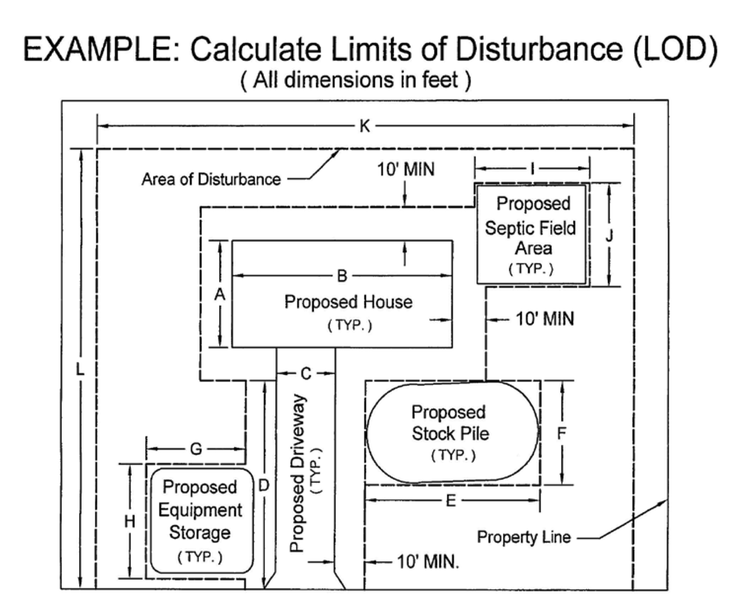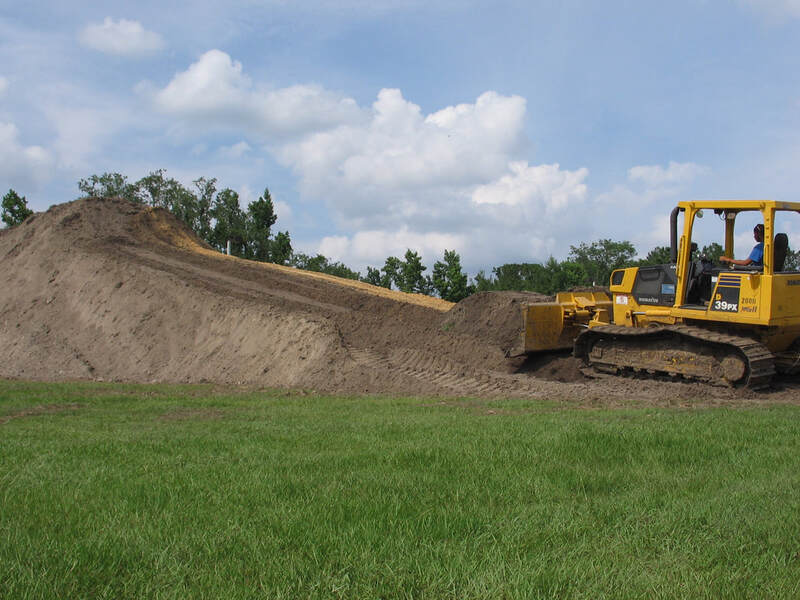
 Preserving the topsoil on your property is a no-brainer. Think about it: why would you damage and remove your property's valuable topsoil during construction, only to spend extra on importing replacement soil when the project is done? Despite current regulations and practices, this approach lacks ethical excavation principles. The persistence of this outdated practice is a result of insufficient awareness about better alternatives. YOU HAVE OPTIONS FOR PRESERVING SOIL! In our tenth post of the Regenerative Design series, we present alternative solutions for ethical excavation and soil preservation techniques that can be seamlessly integrated into your site plan. You might be surprised to learn how easy and efficient these methods are. Preserve Topsoil from Compaction with Zones The best way to safeguard the soil is to leave it alone while preserving the existing vegetation. Unfortunately, this isn't feasible in the location where your home will be built. What IS possible is limiting the “construction footprint” by identifying the minimum space necessary for construction. Working with a builder knowledgeable in regenerative methods can aid in determining the essential disturbance area while ensuring the preservation and protection of the remaining land. Our friends at Heirloom Builders, in Silk Hope, NC, minimize the disturbance and soil compaction on their construction sites by establishing different zones. Limits of Disturbance (LOD) Perimeter Before construction begins, the entire region requiring access is defined by a boundary called the "Limits of Disturbance" (LOD) perimeter. The remaining property outside of the LOD perimeter will remain undisturbed. The perimeter is clearly marked using semi-permanent highly visible fencing to prevent accidental overflow of construction traffic. The LOD directly around the house foundation will vary depending on the terrain, type of equipment needed during construction, and jurisdiction. Some jurisdictions require a 30’ distance between the foundation and limits of disturbance for equipment maneuvering and materials staging. Regardless of jurisdiction, you should anticipate a minimum of 5’- 10’ width. Within the LOD perimeter, different zones are established that designate what type and severity of land disturbance will take place. These zones are established based on the end use of each section of property. Zone 1: Materials and Heavy Machinery Areas that will become the future driveway and certain sections of the lawn are zoned for materials storage and heavy machinery traffic and parking. Zone 2: Foot-Traffic Areas that will become garden spaces and/or mid to deep-rooted plantings are zoned as foot-traffic-only to minimize compaction. In foot-traffic-only zones topsoil and vegetation is NOT removed! Logan Parker, C.E.O and Director of Operations of Heirloom Builders says, “it's easier to leave the soil undisturbed in those places than it is to strip and stockpile it, then come back and till, replace the topsoil and amend it before planting.” Here he’s alluding to all the unnecessary, time consuming, and costly steps that typically take place on a build site. Zone 3: Tree Protection Zone (TPZ) Tree Protection Zones (TPZ) encompass Critical Root Zones (CRZ) around trees and sometimes beyond. The CRZ is the area around the base of the tree where the essential root mass must remain intact and healthy if the tree is to survive. TPZs are areas where construction activities are prohibited, including foot-traffic! Learn more about the minimum area required for keeping soils safe around the base of a tree in our blog How to Protect Trees BEFORE Clearing Your Land: Step-by-Step. Methods for Preserving Topsoil by Stockpiling A simple and cost-effective way to preserve soil on a site is to stockpile it. During the excavation process, the soil that needs to be removed is stockpiled, protected, and saved for reuse once the project is complete. However, this requires planning and needs to be clearly communicated to your builder and excavation team in a regenerative site plan. A zone within the Limits of Disturbance perimeter will need to be designated for stockpiling soils. How to Select Zone for Stockpiling Where you store soil matters because the soil under the stockpile will become compacted. Compaction increases with length of time and height of the pile. The weight of the pile will also impact the structure and biology of the soil within the pile. Because stockpiled soils cause compaction, the zones designated for stockpiling cannot be located on a septic setback or other buffer zone. It must be placed within the Limits of Disturbance perimeter. Once the soils have been stockpiled, they should not be moved until the project is complete. Movement of the soils leads to further compaction and impact on soil biology. So, selecting an area for stockpiling should be carefully thought out and written into a site plan. Optimal Height of Stockpile Different types of soils can sustain different depths of stockpiling without becoming too compacted. Again, the name of the game is to minimize compaction because compaction kills the beneficial organisms in the soil. A sandy loam pile has an optimal height of 6ft. Whereas a pile of clay loam should not be higher than 4ft. How to Cover and Protect Stockpile Covering and protecting your stockpiled topsoil is required to prevent erosion and sedimentation. Do not cover the stockpile with an impervious cover such as a tarp or plastic! Remember, the reason why you want to preserve the soil is because it’s teeming with life. An impervious cover will restrict air flow and increase temperature which may kill soil organisms. Learn about all the soil organisms that keep us alive in our blog The Story of Soil: What It Is, What It Isn’t, and Why You NEED to Protect Soils on Your Property. Instead, protect the stockpile from erosion using mulch, temporary grass mats, woven weed barrier sheeting or other breathable geotextile fabric. How Much Space is Required for Stockpiling Not much! The area required for stockpiling soils does not take as much room as one might think! Logan, at Heirloom Builders, mentions that there is not yet an established rule of thumb for stockpiling soils. He says this is likely due to the current mindset of the industry viewing soil “more like a burden than a blessing.” However, the area he estimates to be reserved for stockpiling soils on one acre (43,560 sq ft) of disturbance is only 1,000 square feet! That’s only 2.3% of the total buildable area! Our friend, Chardin, at Preservation Arborists in Asheville, confirms that “you can fit a lot of soil into a 400sq ft area on a large 8,000 square foot construction site.” That’s only 5% of the total buildable area! These two professionals dedicated to preserving soils have proven that soil stockpiling requires an insignificant amount of space and can easily be planned for with a regenerative site plan established during the home design process. Stockpiling Saves Money Logan points out that “it takes a tremendous amount of time, money, and energy to rebuild the soils that [are] disturbed or removed in the first place. Saving topsoil by keeping it on site is a no-brainer, financially. It’s much faster, cheaper, and simple to keep it on site if you have the room to stockpile for later use.” Working with a home designer who is able to take into consideration the area required to stockpile soils before designing your home for your lot will save you the time, money, and energy Logan speaks of. Erosion Control Keeping the soil ON your site is the name of the game! Ethical excavation also means finding ways to prevent soil erosion. This involves various methods to slow down the movement of soil carried away by wind and water and catch the soil before it leaves your land. Silt fencing is the most widely used technique, though one of the least effective methods of erosion control when not combined with additional techniques. Problems with silt fencing arise with improper installation, faulty or cheap products, and neglectful maintenance. Check out Silt Fence Fails: What Not to Do. Additional effective methods of erosion control include:
Combining multiple techniques will be your best bet for assuring soils stay ON SITE, which is the only place you want them. Soil Success and Septic Systems Soil is not dirt! It’s the source of life. Healthy soils not only grow healthy trees and beautiful yards, it’s also what allows you to have a properly functioning septic system. Without healthy soils you may be significantly limited in location and size of a septic system. Which can impact the size, footprint, and design of your home. Your septic system is an ecosystem that depends on soil. Check us out next time for a shift in perspective about a less-than-glamorous topic that impacts nearly every homeowner in rural and semi-rural areas of the nation. I intend you take the time upfront to develop a regenerative plan that will save you time, money, and soil on the back end. Supportive of you and your land, Jenny Pippin, CPBD, FAIBD, CGP Pippin Home Designs
0 Comments
Leave a Reply. |
AuthorI am Jenny Pippin, founder of Pippin Home Designs and creator of my own inspired living. I grew up as an ordinary southern girl, working in the fields of my family’s tobacco farm. It didn’t take me long to realize I had greater gifts and so I chose to step into my power and create my own path in life, inspired by my heart’s true passion. (More on my personal story HERE!) Archives
February 2024
Categories
All
|
Copyright 2020. Pippin Home Designs. All rights reserved.
ARCHITECTURAL DESIGN COPYRIGHT NOTICE
1987-2024 Copyright. Jennifer B. Pippin FAIBD, CPBD. Pertaining to all home designs, drawings, and photographic imagery of completed designs
presented herein. No part of the contents of the design work presented on this website may be reproduced or transmitted in any form or
by any means, electronic or mechanical, for the purpose of replication or adaptation. This material is intended to provide accurate and
authoritative information about the design abilities and expertise of Jennifer B. Pippin FAIBD, CPBD and Pippin Home Designs.
ARCHITECTURAL DESIGN COPYRIGHT NOTICE
1987-2024 Copyright. Jennifer B. Pippin FAIBD, CPBD. Pertaining to all home designs, drawings, and photographic imagery of completed designs
presented herein. No part of the contents of the design work presented on this website may be reproduced or transmitted in any form or
by any means, electronic or mechanical, for the purpose of replication or adaptation. This material is intended to provide accurate and
authoritative information about the design abilities and expertise of Jennifer B. Pippin FAIBD, CPBD and Pippin Home Designs.









 RSS Feed
RSS Feed
